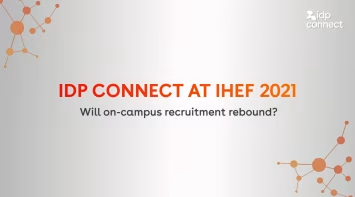Over the last six months, we’ve gone on a journey through, what I consider, foundational elements of successful strategic international student enrollment management. From being purposeful in understanding perspective (both global and internal) and committing to long-term planning to prioritizing selection of appropriate platforms and partnerships, the final two pieces center around people: personalization and the last P, perhaps the most important, yet perhaps least utilized by U.S. colleges and universities in the recruitment process: peers.
Who are Peers?
One of the first rules I learned in admissions in 1993 at my alma mater is that our current students are the best advocates for our college. Hey, that’s why we have them give campus tours, right? Their proximity to the experiences of prospective students and the value their own stories can have on future students cannot be undervalued. However, using peers doesn’t only mean getting current students on board for this initiative. Eventually, you would want to develop a group of students, alumni, current parents, and faculty into the peer recruitment program.
There is value at all points in the enrollment process to have current students (and other peer groups) involved in your direct recruitment efforts. For example, you can utilize many of the following:
AMA (Ask Me Anything) student chats
Virtual Open Houses
Host country-specific chats
Admitted student events
Parent-to-parent chats
Pre-departure orientations
However you define them, whether as international student ambassadors, overseas student guides, etc., peer recruitment can take your institution’s connectedness with your future students to the next level.
Perspective on Peers
As with your institutional perspective on the world, it’s valuable to see how the major markets are utilizing (or not) online peer recruitment (i.e. readily identifiable on institutional websites). In a PIE News webinar on Peer Recruitment in North America earlier this year, Nick Golding from TAP (The Ambassador Platform) shared some fascinating statistics on the usage of peer recruitment in the UK, Australia, and USA/Canada:
• UK – 100 of 150 universities = 66%
• Australia – 33 of 52 colleges/universities = 63%
• USA/Canada – only 150-200 (out of 4500) institutions = <5%
We like to see ourselves in the United States as on the cutting edge, technologically speaking, when it comes to international education. The reality is, when it comes to using peer recruitment with overseas students, we are woefully behind two of our major competitors globally. We can and should always have our antenna out to learn successful strategies from other institutions wherever they may be.
In-house or Outsource?
The question on how you want to set up your program begins and ends with your ability to recruit that initial group of current students. In selecting those first volunteers (or student employees) to fill these important roles, you may need to rely on whomever you can get, but eventually, who you choose should have some connection to your target markets or regions (remember, from our planning piece?). As you train these current students, set clear ground rules on what they can say on which topics and which questions should clearly be referred to admissions staff. Ideally, the key is for these peer recruiters to share their experiences through social media channels, email conversations, live chats, and online events.
Whether you establish a completely in-house student ambassador program or leverage an outside provider (two main ones operate in the U.S. currently: The Ambassador Platform and Unibuddy), make the effort to include elements of peer recruitment in your overall recruitment strategy and beyond. Not only are current students and prospective students a good match, but current students’ parents and prospective students’ parents can be important peer groups to match up during the admissions process as well.
The good news, if there is any to find from the impact of the Covid-19 pandemic on international education, is that many US institutions are now including current students in their outreach to prospective students, according to IIE’s Fall 2020 Snapshot Survey. While 68% of those surveyed do not have an organized program to facilitate interactions throughout the admissions process with prospective students, the seeds of success have been planted at many institutions.

Image courtesy of IIE Fall Snapshot Survey 2020
Putting the Pieces Together
In the end, to do strategic international enrollment management (SIEM) right, we must realize that it is a process and won’t magically coalesce overnight. This process requires us to be purposefully prioritizing people at every stage of development. From the initial prospect through to alumni status, when we first inform our decision-making with the right perspective and commitment to planning, selection of platforms and partners that complement our mission, to a laser focus on personalization and peer recruitment in our messaging, the results can be transformational for your institution.

Keep in mind, this process encompasses the entire student journey before, during, and after enrollment. Take your time and don’t be afraid to ask for help from within your college and beyond!
You might like...

Q&A with Rachel MacSween, Director of Client Partnerships UK and Europe at IDP Connect
In our latest Q&A, Rachel talks all things HE and why the sector continues to inspire her

Counsellor Q&A: Thai perspectives on studying in the UK and attracting more Thai students to UK institutions
Specialist advice from our education counsellors for the Thai student market

2-minute Q&A: Content tips for UK institutions to engage with the Turkish student market
Snapshot interview with Esengul Kercin, Senior Country Marketing Executive for Hotcourses Turkey



